Organisational Behaviour Report: Waitrose - Unit 12 - KCB Assignment
VerifiedAdded on 2023/01/13
|20
|6113
|83
Report
AI Summary
This report delves into the intricacies of organisational behaviour, focusing on Waitrose, a British supermarket chain. It examines the influence of culture, politics, and power dynamics on employee behaviour, analyzing Handy's cultural typology, the impact of individual and organisational politics, and French and Raven's five forms of power. The report further evaluates motivational theories, particularly the content and process theories, including Maslow's Need Hierarchy. It explores effective and ineffective team dynamics, identifying factors that influence cooperation and productivity. Finally, the report applies organisational behaviour concepts and philosophies to a Waitrose business scenario, offering insights into enhancing employee motivation, fostering teamwork, and achieving organisational goals.
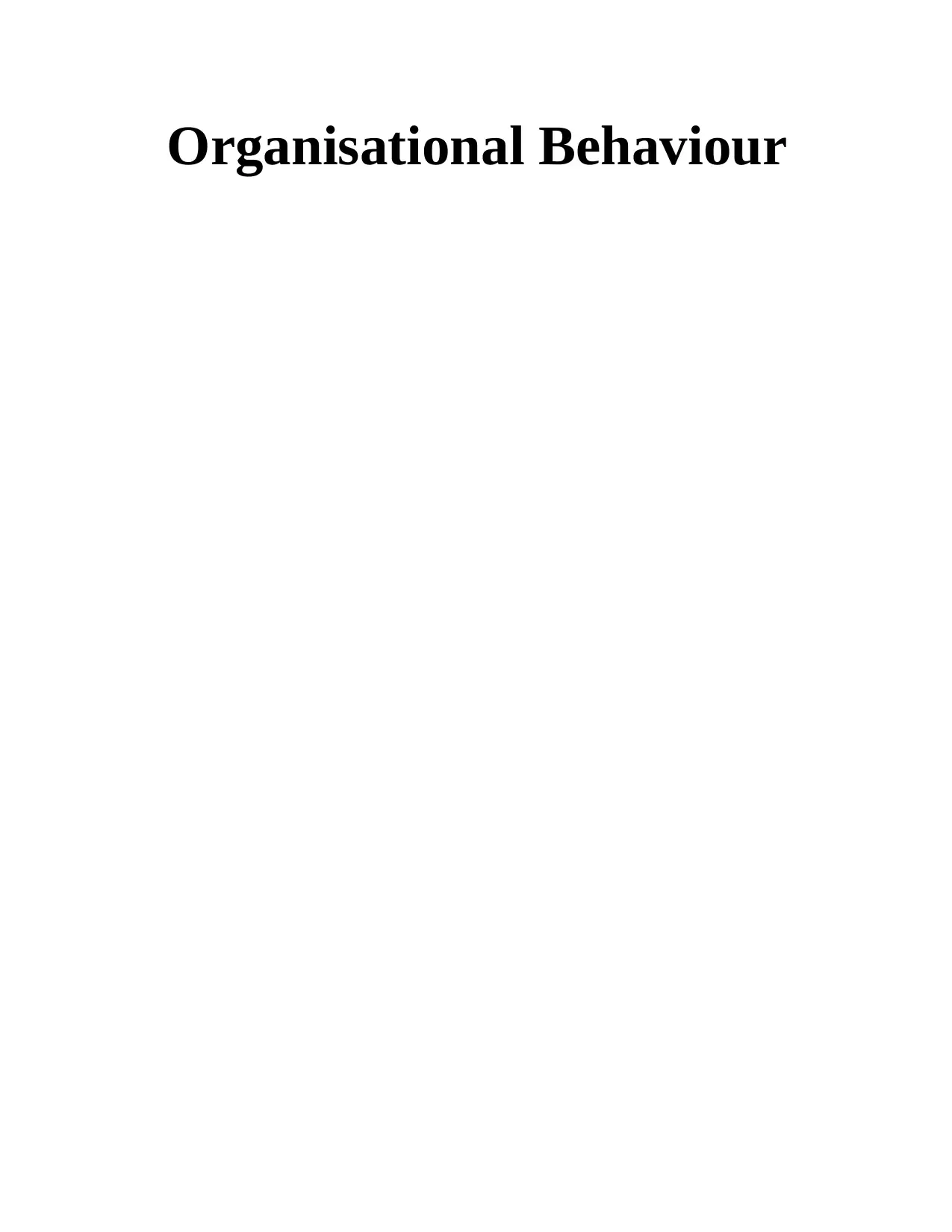
Organisational Behaviour
Paraphrase This Document
Need a fresh take? Get an instant paraphrase of this document with our AI Paraphraser
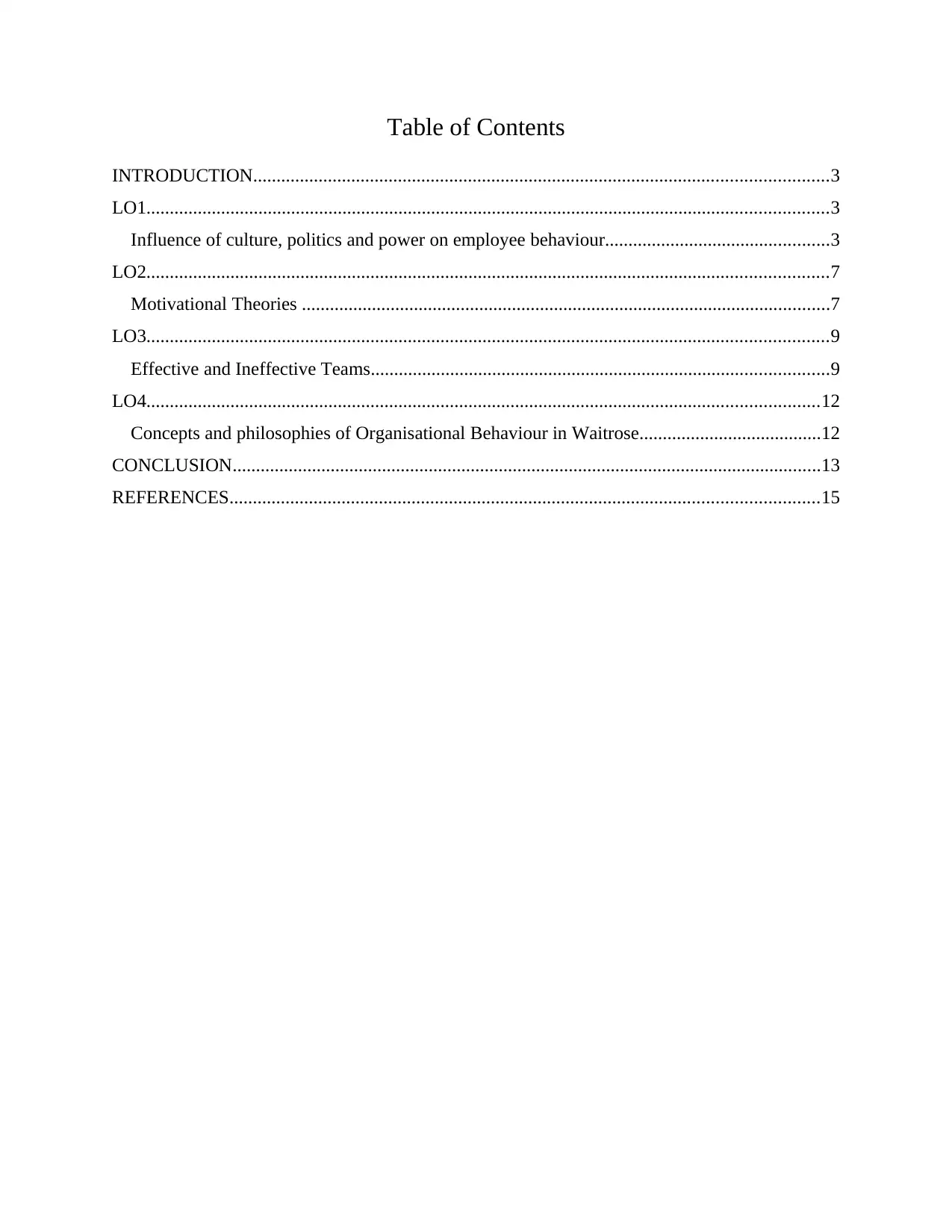
Table of Contents
INTRODUCTION...........................................................................................................................3
LO1..................................................................................................................................................3
Influence of culture, politics and power on employee behaviour................................................3
LO2..................................................................................................................................................7
Motivational Theories .................................................................................................................7
LO3..................................................................................................................................................9
Effective and Ineffective Teams..................................................................................................9
LO4................................................................................................................................................12
Concepts and philosophies of Organisational Behaviour in Waitrose.......................................12
CONCLUSION..............................................................................................................................13
REFERENCES..............................................................................................................................15
INTRODUCTION...........................................................................................................................3
LO1..................................................................................................................................................3
Influence of culture, politics and power on employee behaviour................................................3
LO2..................................................................................................................................................7
Motivational Theories .................................................................................................................7
LO3..................................................................................................................................................9
Effective and Ineffective Teams..................................................................................................9
LO4................................................................................................................................................12
Concepts and philosophies of Organisational Behaviour in Waitrose.......................................12
CONCLUSION..............................................................................................................................13
REFERENCES..............................................................................................................................15
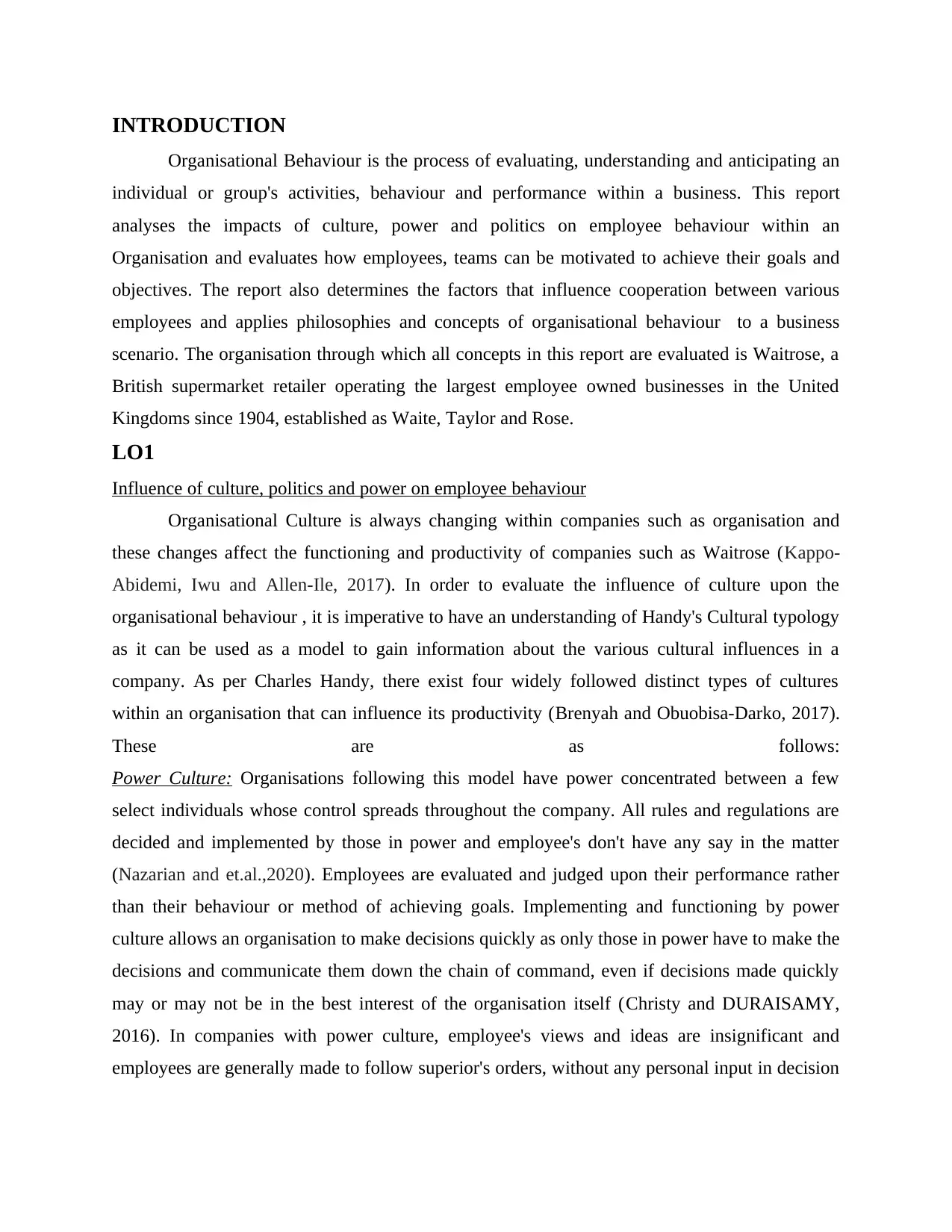
INTRODUCTION
Organisational Behaviour is the process of evaluating, understanding and anticipating an
individual or group's activities, behaviour and performance within a business. This report
analyses the impacts of culture, power and politics on employee behaviour within an
Organisation and evaluates how employees, teams can be motivated to achieve their goals and
objectives. The report also determines the factors that influence cooperation between various
employees and applies philosophies and concepts of organisational behaviour to a business
scenario. The organisation through which all concepts in this report are evaluated is Waitrose, a
British supermarket retailer operating the largest employee owned businesses in the United
Kingdoms since 1904, established as Waite, Taylor and Rose.
LO1
Influence of culture, politics and power on employee behaviour
Organisational Culture is always changing within companies such as organisation and
these changes affect the functioning and productivity of companies such as Waitrose (Kappo-
Abidemi, Iwu and Allen-Ile, 2017). In order to evaluate the influence of culture upon the
organisational behaviour , it is imperative to have an understanding of Handy's Cultural typology
as it can be used as a model to gain information about the various cultural influences in a
company. As per Charles Handy, there exist four widely followed distinct types of cultures
within an organisation that can influence its productivity (Brenyah and Obuobisa-Darko, 2017).
These are as follows:
Power Culture: Organisations following this model have power concentrated between a few
select individuals whose control spreads throughout the company. All rules and regulations are
decided and implemented by those in power and employee's don't have any say in the matter
(Nazarian and et.al.,2020). Employees are evaluated and judged upon their performance rather
than their behaviour or method of achieving goals. Implementing and functioning by power
culture allows an organisation to make decisions quickly as only those in power have to make the
decisions and communicate them down the chain of command, even if decisions made quickly
may or may not be in the best interest of the organisation itself (Christy and DURAISAMY,
2016). In companies with power culture, employee's views and ideas are insignificant and
employees are generally made to follow superior's orders, without any personal input in decision
Organisational Behaviour is the process of evaluating, understanding and anticipating an
individual or group's activities, behaviour and performance within a business. This report
analyses the impacts of culture, power and politics on employee behaviour within an
Organisation and evaluates how employees, teams can be motivated to achieve their goals and
objectives. The report also determines the factors that influence cooperation between various
employees and applies philosophies and concepts of organisational behaviour to a business
scenario. The organisation through which all concepts in this report are evaluated is Waitrose, a
British supermarket retailer operating the largest employee owned businesses in the United
Kingdoms since 1904, established as Waite, Taylor and Rose.
LO1
Influence of culture, politics and power on employee behaviour
Organisational Culture is always changing within companies such as organisation and
these changes affect the functioning and productivity of companies such as Waitrose (Kappo-
Abidemi, Iwu and Allen-Ile, 2017). In order to evaluate the influence of culture upon the
organisational behaviour , it is imperative to have an understanding of Handy's Cultural typology
as it can be used as a model to gain information about the various cultural influences in a
company. As per Charles Handy, there exist four widely followed distinct types of cultures
within an organisation that can influence its productivity (Brenyah and Obuobisa-Darko, 2017).
These are as follows:
Power Culture: Organisations following this model have power concentrated between a few
select individuals whose control spreads throughout the company. All rules and regulations are
decided and implemented by those in power and employee's don't have any say in the matter
(Nazarian and et.al.,2020). Employees are evaluated and judged upon their performance rather
than their behaviour or method of achieving goals. Implementing and functioning by power
culture allows an organisation to make decisions quickly as only those in power have to make the
decisions and communicate them down the chain of command, even if decisions made quickly
may or may not be in the best interest of the organisation itself (Christy and DURAISAMY,
2016). In companies with power culture, employee's views and ideas are insignificant and
employees are generally made to follow superior's orders, without any personal input in decision
⊘ This is a preview!⊘
Do you want full access?
Subscribe today to unlock all pages.

Trusted by 1+ million students worldwide
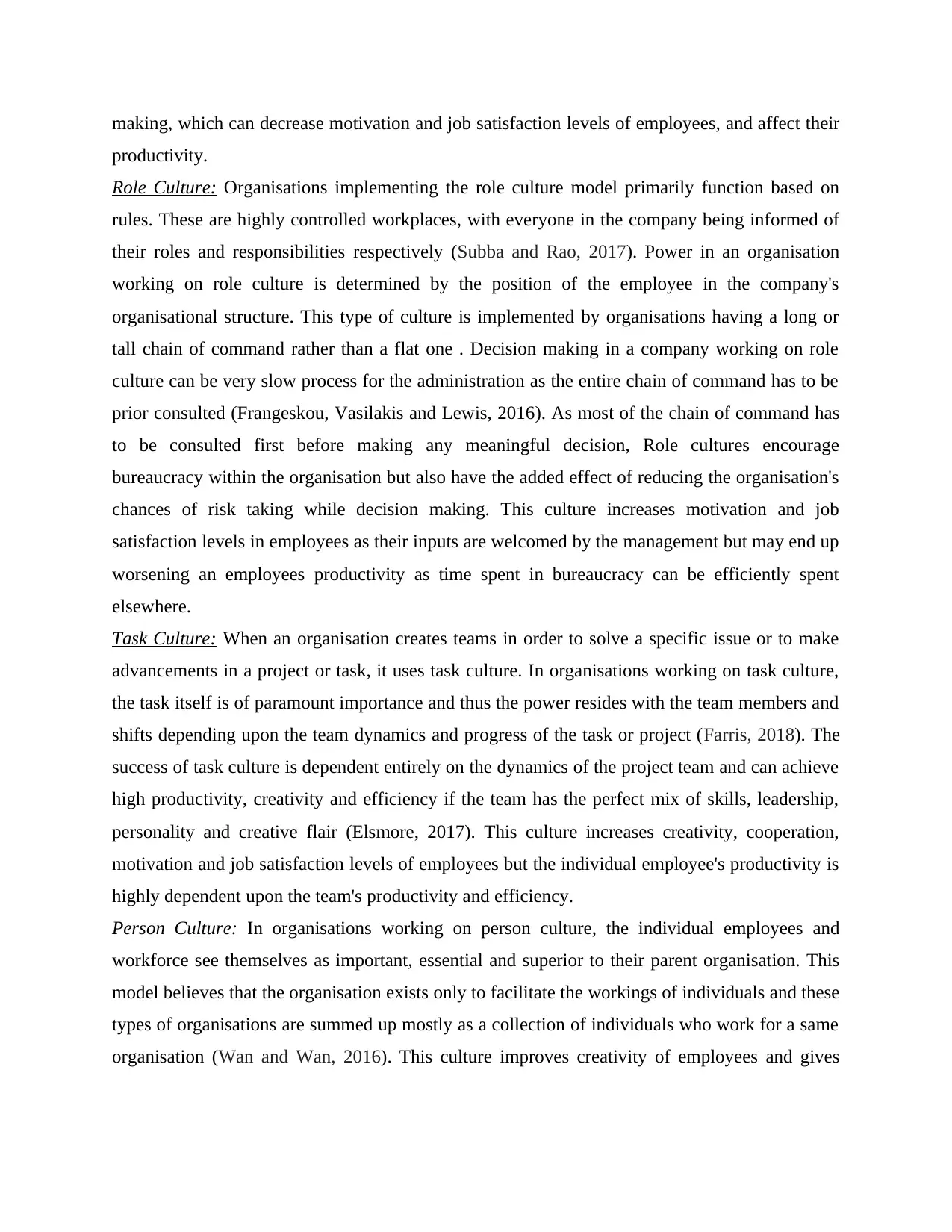
making, which can decrease motivation and job satisfaction levels of employees, and affect their
productivity.
Role Culture: Organisations implementing the role culture model primarily function based on
rules. These are highly controlled workplaces, with everyone in the company being informed of
their roles and responsibilities respectively (Subba and Rao, 2017). Power in an organisation
working on role culture is determined by the position of the employee in the company's
organisational structure. This type of culture is implemented by organisations having a long or
tall chain of command rather than a flat one . Decision making in a company working on role
culture can be very slow process for the administration as the entire chain of command has to be
prior consulted (Frangeskou, Vasilakis and Lewis, 2016). As most of the chain of command has
to be consulted first before making any meaningful decision, Role cultures encourage
bureaucracy within the organisation but also have the added effect of reducing the organisation's
chances of risk taking while decision making. This culture increases motivation and job
satisfaction levels in employees as their inputs are welcomed by the management but may end up
worsening an employees productivity as time spent in bureaucracy can be efficiently spent
elsewhere.
Task Culture: When an organisation creates teams in order to solve a specific issue or to make
advancements in a project or task, it uses task culture. In organisations working on task culture,
the task itself is of paramount importance and thus the power resides with the team members and
shifts depending upon the team dynamics and progress of the task or project (Farris, 2018). The
success of task culture is dependent entirely on the dynamics of the project team and can achieve
high productivity, creativity and efficiency if the team has the perfect mix of skills, leadership,
personality and creative flair (Elsmore, 2017). This culture increases creativity, cooperation,
motivation and job satisfaction levels of employees but the individual employee's productivity is
highly dependent upon the team's productivity and efficiency.
Person Culture: In organisations working on person culture, the individual employees and
workforce see themselves as important, essential and superior to their parent organisation. This
model believes that the organisation exists only to facilitate the workings of individuals and these
types of organisations are summed up mostly as a collection of individuals who work for a same
organisation (Wan and Wan, 2016). This culture improves creativity of employees and gives
productivity.
Role Culture: Organisations implementing the role culture model primarily function based on
rules. These are highly controlled workplaces, with everyone in the company being informed of
their roles and responsibilities respectively (Subba and Rao, 2017). Power in an organisation
working on role culture is determined by the position of the employee in the company's
organisational structure. This type of culture is implemented by organisations having a long or
tall chain of command rather than a flat one . Decision making in a company working on role
culture can be very slow process for the administration as the entire chain of command has to be
prior consulted (Frangeskou, Vasilakis and Lewis, 2016). As most of the chain of command has
to be consulted first before making any meaningful decision, Role cultures encourage
bureaucracy within the organisation but also have the added effect of reducing the organisation's
chances of risk taking while decision making. This culture increases motivation and job
satisfaction levels in employees as their inputs are welcomed by the management but may end up
worsening an employees productivity as time spent in bureaucracy can be efficiently spent
elsewhere.
Task Culture: When an organisation creates teams in order to solve a specific issue or to make
advancements in a project or task, it uses task culture. In organisations working on task culture,
the task itself is of paramount importance and thus the power resides with the team members and
shifts depending upon the team dynamics and progress of the task or project (Farris, 2018). The
success of task culture is dependent entirely on the dynamics of the project team and can achieve
high productivity, creativity and efficiency if the team has the perfect mix of skills, leadership,
personality and creative flair (Elsmore, 2017). This culture increases creativity, cooperation,
motivation and job satisfaction levels of employees but the individual employee's productivity is
highly dependent upon the team's productivity and efficiency.
Person Culture: In organisations working on person culture, the individual employees and
workforce see themselves as important, essential and superior to their parent organisation. This
model believes that the organisation exists only to facilitate the workings of individuals and these
types of organisations are summed up mostly as a collection of individuals who work for a same
organisation (Wan and Wan, 2016). This culture improves creativity of employees and gives
Paraphrase This Document
Need a fresh take? Get an instant paraphrase of this document with our AI Paraphraser
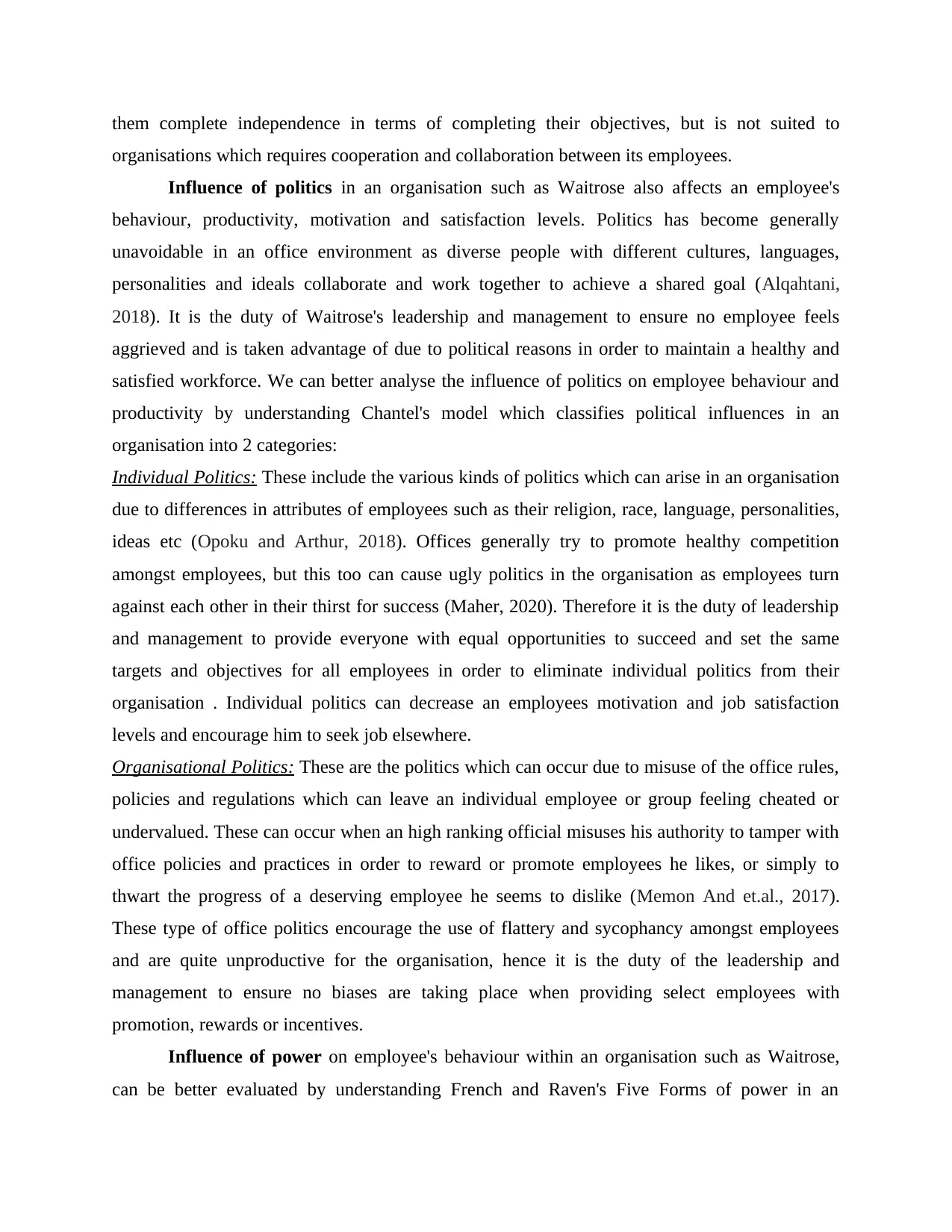
them complete independence in terms of completing their objectives, but is not suited to
organisations which requires cooperation and collaboration between its employees.
Influence of politics in an organisation such as Waitrose also affects an employee's
behaviour, productivity, motivation and satisfaction levels. Politics has become generally
unavoidable in an office environment as diverse people with different cultures, languages,
personalities and ideals collaborate and work together to achieve a shared goal (Alqahtani,
2018). It is the duty of Waitrose's leadership and management to ensure no employee feels
aggrieved and is taken advantage of due to political reasons in order to maintain a healthy and
satisfied workforce. We can better analyse the influence of politics on employee behaviour and
productivity by understanding Chantel's model which classifies political influences in an
organisation into 2 categories:
Individual Politics: These include the various kinds of politics which can arise in an organisation
due to differences in attributes of employees such as their religion, race, language, personalities,
ideas etc (Opoku and Arthur, 2018). Offices generally try to promote healthy competition
amongst employees, but this too can cause ugly politics in the organisation as employees turn
against each other in their thirst for success (Maher, 2020). Therefore it is the duty of leadership
and management to provide everyone with equal opportunities to succeed and set the same
targets and objectives for all employees in order to eliminate individual politics from their
organisation . Individual politics can decrease an employees motivation and job satisfaction
levels and encourage him to seek job elsewhere.
Organisational Politics: These are the politics which can occur due to misuse of the office rules,
policies and regulations which can leave an individual employee or group feeling cheated or
undervalued. These can occur when an high ranking official misuses his authority to tamper with
office policies and practices in order to reward or promote employees he likes, or simply to
thwart the progress of a deserving employee he seems to dislike (Memon And et.al., 2017).
These type of office politics encourage the use of flattery and sycophancy amongst employees
and are quite unproductive for the organisation, hence it is the duty of the leadership and
management to ensure no biases are taking place when providing select employees with
promotion, rewards or incentives.
Influence of power on employee's behaviour within an organisation such as Waitrose,
can be better evaluated by understanding French and Raven's Five Forms of power in an
organisations which requires cooperation and collaboration between its employees.
Influence of politics in an organisation such as Waitrose also affects an employee's
behaviour, productivity, motivation and satisfaction levels. Politics has become generally
unavoidable in an office environment as diverse people with different cultures, languages,
personalities and ideals collaborate and work together to achieve a shared goal (Alqahtani,
2018). It is the duty of Waitrose's leadership and management to ensure no employee feels
aggrieved and is taken advantage of due to political reasons in order to maintain a healthy and
satisfied workforce. We can better analyse the influence of politics on employee behaviour and
productivity by understanding Chantel's model which classifies political influences in an
organisation into 2 categories:
Individual Politics: These include the various kinds of politics which can arise in an organisation
due to differences in attributes of employees such as their religion, race, language, personalities,
ideas etc (Opoku and Arthur, 2018). Offices generally try to promote healthy competition
amongst employees, but this too can cause ugly politics in the organisation as employees turn
against each other in their thirst for success (Maher, 2020). Therefore it is the duty of leadership
and management to provide everyone with equal opportunities to succeed and set the same
targets and objectives for all employees in order to eliminate individual politics from their
organisation . Individual politics can decrease an employees motivation and job satisfaction
levels and encourage him to seek job elsewhere.
Organisational Politics: These are the politics which can occur due to misuse of the office rules,
policies and regulations which can leave an individual employee or group feeling cheated or
undervalued. These can occur when an high ranking official misuses his authority to tamper with
office policies and practices in order to reward or promote employees he likes, or simply to
thwart the progress of a deserving employee he seems to dislike (Memon And et.al., 2017).
These type of office politics encourage the use of flattery and sycophancy amongst employees
and are quite unproductive for the organisation, hence it is the duty of the leadership and
management to ensure no biases are taking place when providing select employees with
promotion, rewards or incentives.
Influence of power on employee's behaviour within an organisation such as Waitrose,
can be better evaluated by understanding French and Raven's Five Forms of power in an
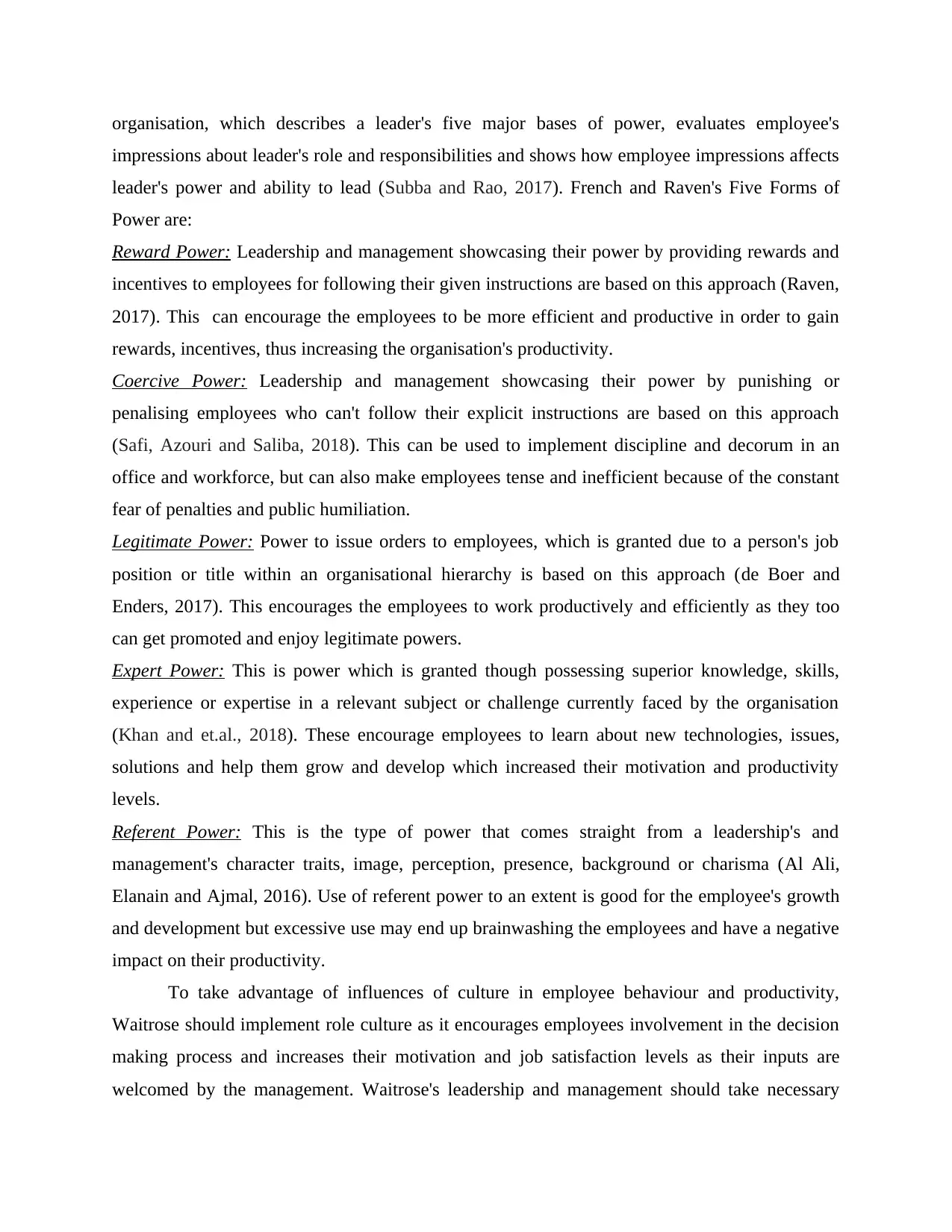
organisation, which describes a leader's five major bases of power, evaluates employee's
impressions about leader's role and responsibilities and shows how employee impressions affects
leader's power and ability to lead (Subba and Rao, 2017). French and Raven's Five Forms of
Power are:
Reward Power: Leadership and management showcasing their power by providing rewards and
incentives to employees for following their given instructions are based on this approach (Raven,
2017). This can encourage the employees to be more efficient and productive in order to gain
rewards, incentives, thus increasing the organisation's productivity.
Coercive Power: Leadership and management showcasing their power by punishing or
penalising employees who can't follow their explicit instructions are based on this approach
(Safi, Azouri and Saliba, 2018). This can be used to implement discipline and decorum in an
office and workforce, but can also make employees tense and inefficient because of the constant
fear of penalties and public humiliation.
Legitimate Power: Power to issue orders to employees, which is granted due to a person's job
position or title within an organisational hierarchy is based on this approach (de Boer and
Enders, 2017). This encourages the employees to work productively and efficiently as they too
can get promoted and enjoy legitimate powers.
Expert Power: This is power which is granted though possessing superior knowledge, skills,
experience or expertise in a relevant subject or challenge currently faced by the organisation
(Khan and et.al., 2018). These encourage employees to learn about new technologies, issues,
solutions and help them grow and develop which increased their motivation and productivity
levels.
Referent Power: This is the type of power that comes straight from a leadership's and
management's character traits, image, perception, presence, background or charisma (Al Ali,
Elanain and Ajmal, 2016). Use of referent power to an extent is good for the employee's growth
and development but excessive use may end up brainwashing the employees and have a negative
impact on their productivity.
To take advantage of influences of culture in employee behaviour and productivity,
Waitrose should implement role culture as it encourages employees involvement in the decision
making process and increases their motivation and job satisfaction levels as their inputs are
welcomed by the management. Waitrose's leadership and management should take necessary
impressions about leader's role and responsibilities and shows how employee impressions affects
leader's power and ability to lead (Subba and Rao, 2017). French and Raven's Five Forms of
Power are:
Reward Power: Leadership and management showcasing their power by providing rewards and
incentives to employees for following their given instructions are based on this approach (Raven,
2017). This can encourage the employees to be more efficient and productive in order to gain
rewards, incentives, thus increasing the organisation's productivity.
Coercive Power: Leadership and management showcasing their power by punishing or
penalising employees who can't follow their explicit instructions are based on this approach
(Safi, Azouri and Saliba, 2018). This can be used to implement discipline and decorum in an
office and workforce, but can also make employees tense and inefficient because of the constant
fear of penalties and public humiliation.
Legitimate Power: Power to issue orders to employees, which is granted due to a person's job
position or title within an organisational hierarchy is based on this approach (de Boer and
Enders, 2017). This encourages the employees to work productively and efficiently as they too
can get promoted and enjoy legitimate powers.
Expert Power: This is power which is granted though possessing superior knowledge, skills,
experience or expertise in a relevant subject or challenge currently faced by the organisation
(Khan and et.al., 2018). These encourage employees to learn about new technologies, issues,
solutions and help them grow and develop which increased their motivation and productivity
levels.
Referent Power: This is the type of power that comes straight from a leadership's and
management's character traits, image, perception, presence, background or charisma (Al Ali,
Elanain and Ajmal, 2016). Use of referent power to an extent is good for the employee's growth
and development but excessive use may end up brainwashing the employees and have a negative
impact on their productivity.
To take advantage of influences of culture in employee behaviour and productivity,
Waitrose should implement role culture as it encourages employees involvement in the decision
making process and increases their motivation and job satisfaction levels as their inputs are
welcomed by the management. Waitrose's leadership and management should take necessary
⊘ This is a preview!⊘
Do you want full access?
Subscribe today to unlock all pages.

Trusted by 1+ million students worldwide
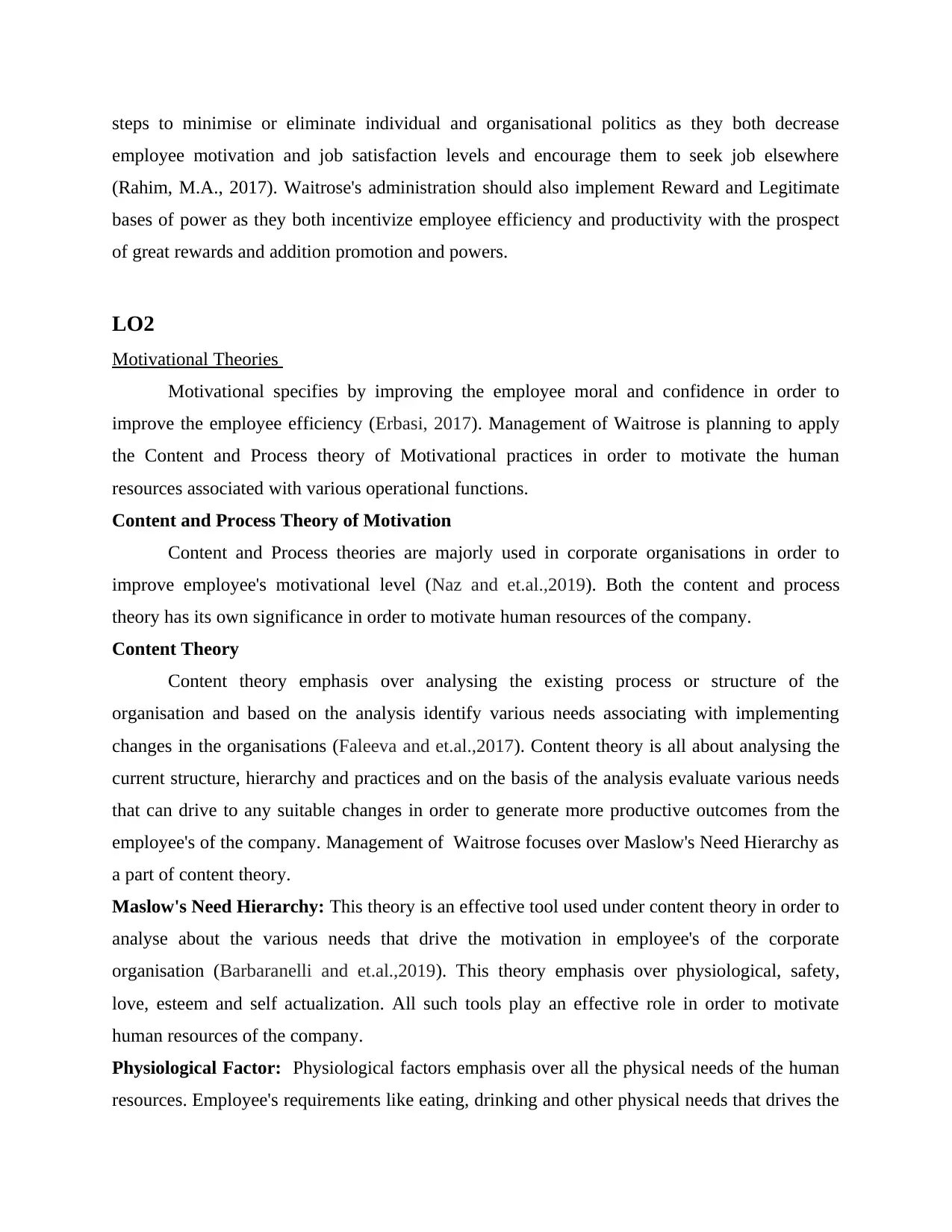
steps to minimise or eliminate individual and organisational politics as they both decrease
employee motivation and job satisfaction levels and encourage them to seek job elsewhere
(Rahim, M.A., 2017). Waitrose's administration should also implement Reward and Legitimate
bases of power as they both incentivize employee efficiency and productivity with the prospect
of great rewards and addition promotion and powers.
LO2
Motivational Theories
Motivational specifies by improving the employee moral and confidence in order to
improve the employee efficiency (Erbasi, 2017). Management of Waitrose is planning to apply
the Content and Process theory of Motivational practices in order to motivate the human
resources associated with various operational functions.
Content and Process Theory of Motivation
Content and Process theories are majorly used in corporate organisations in order to
improve employee's motivational level (Naz and et.al.,2019). Both the content and process
theory has its own significance in order to motivate human resources of the company.
Content Theory
Content theory emphasis over analysing the existing process or structure of the
organisation and based on the analysis identify various needs associating with implementing
changes in the organisations (Faleeva and et.al.,2017). Content theory is all about analysing the
current structure, hierarchy and practices and on the basis of the analysis evaluate various needs
that can drive to any suitable changes in order to generate more productive outcomes from the
employee's of the company. Management of Waitrose focuses over Maslow's Need Hierarchy as
a part of content theory.
Maslow's Need Hierarchy: This theory is an effective tool used under content theory in order to
analyse about the various needs that drive the motivation in employee's of the corporate
organisation (Barbaranelli and et.al.,2019). This theory emphasis over physiological, safety,
love, esteem and self actualization. All such tools play an effective role in order to motivate
human resources of the company.
Physiological Factor: Physiological factors emphasis over all the physical needs of the human
resources. Employee's requirements like eating, drinking and other physical needs that drives the
employee motivation and job satisfaction levels and encourage them to seek job elsewhere
(Rahim, M.A., 2017). Waitrose's administration should also implement Reward and Legitimate
bases of power as they both incentivize employee efficiency and productivity with the prospect
of great rewards and addition promotion and powers.
LO2
Motivational Theories
Motivational specifies by improving the employee moral and confidence in order to
improve the employee efficiency (Erbasi, 2017). Management of Waitrose is planning to apply
the Content and Process theory of Motivational practices in order to motivate the human
resources associated with various operational functions.
Content and Process Theory of Motivation
Content and Process theories are majorly used in corporate organisations in order to
improve employee's motivational level (Naz and et.al.,2019). Both the content and process
theory has its own significance in order to motivate human resources of the company.
Content Theory
Content theory emphasis over analysing the existing process or structure of the
organisation and based on the analysis identify various needs associating with implementing
changes in the organisations (Faleeva and et.al.,2017). Content theory is all about analysing the
current structure, hierarchy and practices and on the basis of the analysis evaluate various needs
that can drive to any suitable changes in order to generate more productive outcomes from the
employee's of the company. Management of Waitrose focuses over Maslow's Need Hierarchy as
a part of content theory.
Maslow's Need Hierarchy: This theory is an effective tool used under content theory in order to
analyse about the various needs that drive the motivation in employee's of the corporate
organisation (Barbaranelli and et.al.,2019). This theory emphasis over physiological, safety,
love, esteem and self actualization. All such tools play an effective role in order to motivate
human resources of the company.
Physiological Factor: Physiological factors emphasis over all the physical needs of the human
resources. Employee's requirements like eating, drinking and other physical needs that drives the
Paraphrase This Document
Need a fresh take? Get an instant paraphrase of this document with our AI Paraphraser
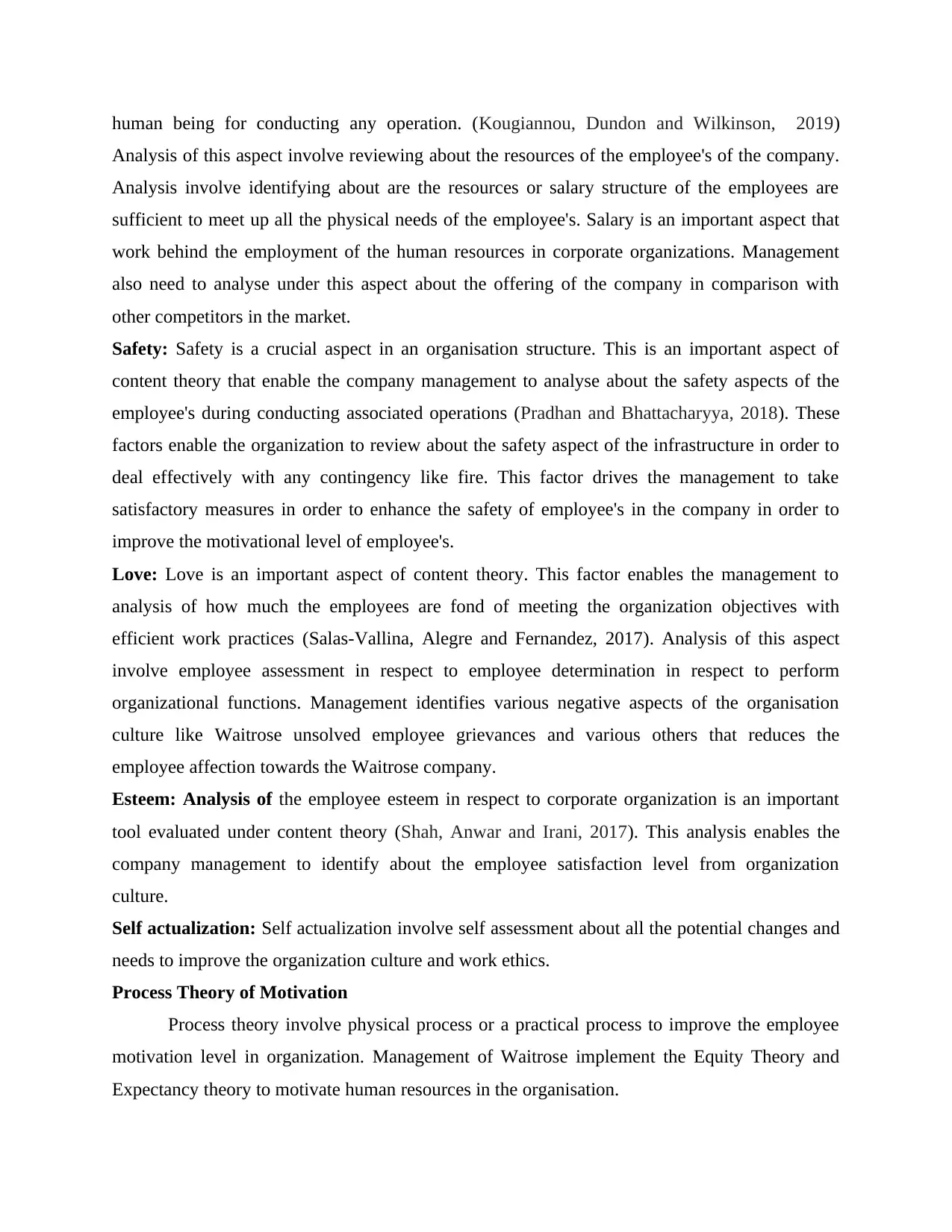
human being for conducting any operation. (Kougiannou, Dundon and Wilkinson, 2019)
Analysis of this aspect involve reviewing about the resources of the employee's of the company.
Analysis involve identifying about are the resources or salary structure of the employees are
sufficient to meet up all the physical needs of the employee's. Salary is an important aspect that
work behind the employment of the human resources in corporate organizations. Management
also need to analyse under this aspect about the offering of the company in comparison with
other competitors in the market.
Safety: Safety is a crucial aspect in an organisation structure. This is an important aspect of
content theory that enable the company management to analyse about the safety aspects of the
employee's during conducting associated operations (Pradhan and Bhattacharyya, 2018). These
factors enable the organization to review about the safety aspect of the infrastructure in order to
deal effectively with any contingency like fire. This factor drives the management to take
satisfactory measures in order to enhance the safety of employee's in the company in order to
improve the motivational level of employee's.
Love: Love is an important aspect of content theory. This factor enables the management to
analysis of how much the employees are fond of meeting the organization objectives with
efficient work practices (Salas-Vallina, Alegre and Fernandez, 2017). Analysis of this aspect
involve employee assessment in respect to employee determination in respect to perform
organizational functions. Management identifies various negative aspects of the organisation
culture like Waitrose unsolved employee grievances and various others that reduces the
employee affection towards the Waitrose company.
Esteem: Analysis of the employee esteem in respect to corporate organization is an important
tool evaluated under content theory (Shah, Anwar and Irani, 2017). This analysis enables the
company management to identify about the employee satisfaction level from organization
culture.
Self actualization: Self actualization involve self assessment about all the potential changes and
needs to improve the organization culture and work ethics.
Process Theory of Motivation
Process theory involve physical process or a practical process to improve the employee
motivation level in organization. Management of Waitrose implement the Equity Theory and
Expectancy theory to motivate human resources in the organisation.
Analysis of this aspect involve reviewing about the resources of the employee's of the company.
Analysis involve identifying about are the resources or salary structure of the employees are
sufficient to meet up all the physical needs of the employee's. Salary is an important aspect that
work behind the employment of the human resources in corporate organizations. Management
also need to analyse under this aspect about the offering of the company in comparison with
other competitors in the market.
Safety: Safety is a crucial aspect in an organisation structure. This is an important aspect of
content theory that enable the company management to analyse about the safety aspects of the
employee's during conducting associated operations (Pradhan and Bhattacharyya, 2018). These
factors enable the organization to review about the safety aspect of the infrastructure in order to
deal effectively with any contingency like fire. This factor drives the management to take
satisfactory measures in order to enhance the safety of employee's in the company in order to
improve the motivational level of employee's.
Love: Love is an important aspect of content theory. This factor enables the management to
analysis of how much the employees are fond of meeting the organization objectives with
efficient work practices (Salas-Vallina, Alegre and Fernandez, 2017). Analysis of this aspect
involve employee assessment in respect to employee determination in respect to perform
organizational functions. Management identifies various negative aspects of the organisation
culture like Waitrose unsolved employee grievances and various others that reduces the
employee affection towards the Waitrose company.
Esteem: Analysis of the employee esteem in respect to corporate organization is an important
tool evaluated under content theory (Shah, Anwar and Irani, 2017). This analysis enables the
company management to identify about the employee satisfaction level from organization
culture.
Self actualization: Self actualization involve self assessment about all the potential changes and
needs to improve the organization culture and work ethics.
Process Theory of Motivation
Process theory involve physical process or a practical process to improve the employee
motivation level in organization. Management of Waitrose implement the Equity Theory and
Expectancy theory to motivate human resources in the organisation.
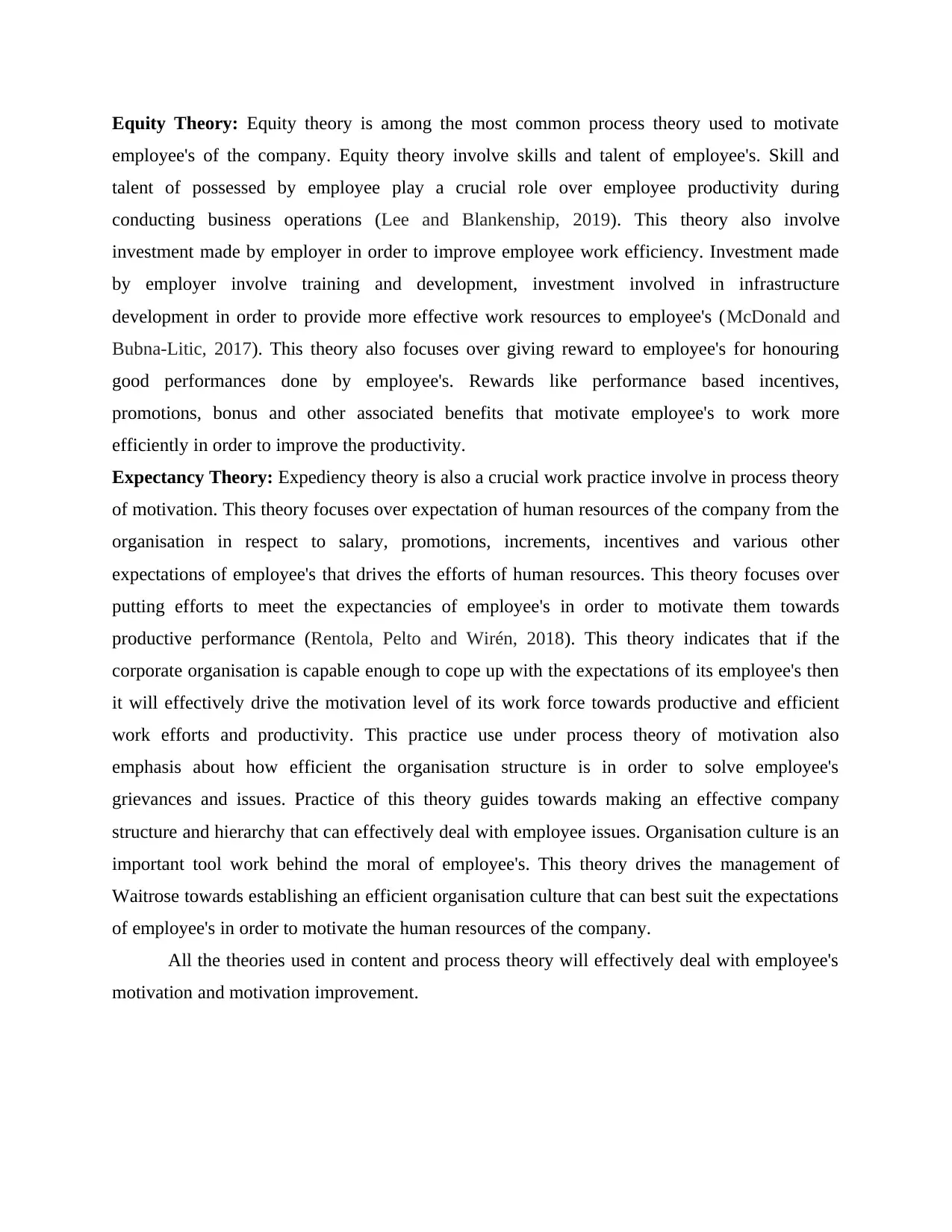
Equity Theory: Equity theory is among the most common process theory used to motivate
employee's of the company. Equity theory involve skills and talent of employee's. Skill and
talent of possessed by employee play a crucial role over employee productivity during
conducting business operations (Lee and Blankenship, 2019). This theory also involve
investment made by employer in order to improve employee work efficiency. Investment made
by employer involve training and development, investment involved in infrastructure
development in order to provide more effective work resources to employee's (McDonald and
Bubna-Litic, 2017). This theory also focuses over giving reward to employee's for honouring
good performances done by employee's. Rewards like performance based incentives,
promotions, bonus and other associated benefits that motivate employee's to work more
efficiently in order to improve the productivity.
Expectancy Theory: Expediency theory is also a crucial work practice involve in process theory
of motivation. This theory focuses over expectation of human resources of the company from the
organisation in respect to salary, promotions, increments, incentives and various other
expectations of employee's that drives the efforts of human resources. This theory focuses over
putting efforts to meet the expectancies of employee's in order to motivate them towards
productive performance (Rentola, Pelto and Wirén, 2018). This theory indicates that if the
corporate organisation is capable enough to cope up with the expectations of its employee's then
it will effectively drive the motivation level of its work force towards productive and efficient
work efforts and productivity. This practice use under process theory of motivation also
emphasis about how efficient the organisation structure is in order to solve employee's
grievances and issues. Practice of this theory guides towards making an effective company
structure and hierarchy that can effectively deal with employee issues. Organisation culture is an
important tool work behind the moral of employee's. This theory drives the management of
Waitrose towards establishing an efficient organisation culture that can best suit the expectations
of employee's in order to motivate the human resources of the company.
All the theories used in content and process theory will effectively deal with employee's
motivation and motivation improvement.
employee's of the company. Equity theory involve skills and talent of employee's. Skill and
talent of possessed by employee play a crucial role over employee productivity during
conducting business operations (Lee and Blankenship, 2019). This theory also involve
investment made by employer in order to improve employee work efficiency. Investment made
by employer involve training and development, investment involved in infrastructure
development in order to provide more effective work resources to employee's (McDonald and
Bubna-Litic, 2017). This theory also focuses over giving reward to employee's for honouring
good performances done by employee's. Rewards like performance based incentives,
promotions, bonus and other associated benefits that motivate employee's to work more
efficiently in order to improve the productivity.
Expectancy Theory: Expediency theory is also a crucial work practice involve in process theory
of motivation. This theory focuses over expectation of human resources of the company from the
organisation in respect to salary, promotions, increments, incentives and various other
expectations of employee's that drives the efforts of human resources. This theory focuses over
putting efforts to meet the expectancies of employee's in order to motivate them towards
productive performance (Rentola, Pelto and Wirén, 2018). This theory indicates that if the
corporate organisation is capable enough to cope up with the expectations of its employee's then
it will effectively drive the motivation level of its work force towards productive and efficient
work efforts and productivity. This practice use under process theory of motivation also
emphasis about how efficient the organisation structure is in order to solve employee's
grievances and issues. Practice of this theory guides towards making an effective company
structure and hierarchy that can effectively deal with employee issues. Organisation culture is an
important tool work behind the moral of employee's. This theory drives the management of
Waitrose towards establishing an efficient organisation culture that can best suit the expectations
of employee's in order to motivate the human resources of the company.
All the theories used in content and process theory will effectively deal with employee's
motivation and motivation improvement.
⊘ This is a preview!⊘
Do you want full access?
Subscribe today to unlock all pages.

Trusted by 1+ million students worldwide
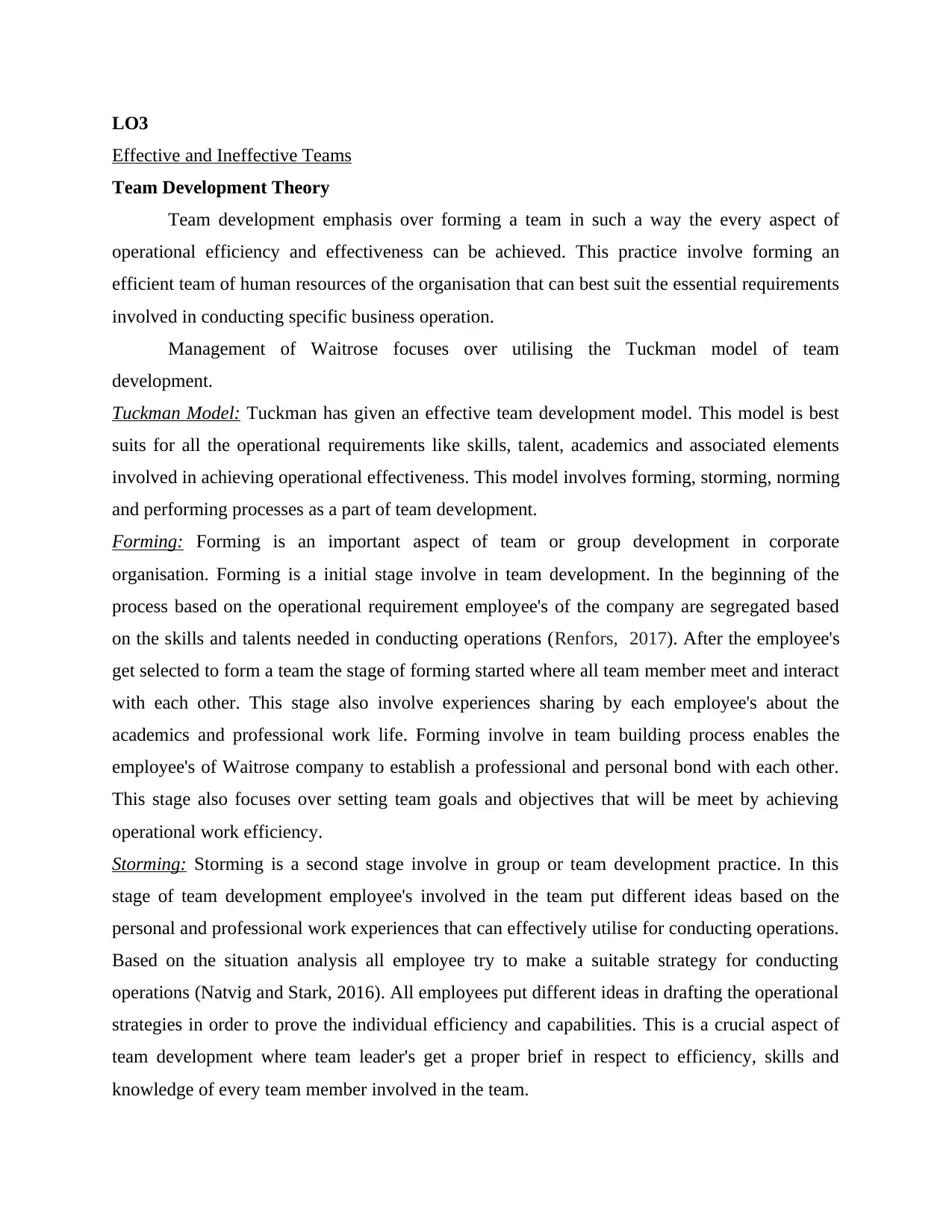
LO3
Effective and Ineffective Teams
Team Development Theory
Team development emphasis over forming a team in such a way the every aspect of
operational efficiency and effectiveness can be achieved. This practice involve forming an
efficient team of human resources of the organisation that can best suit the essential requirements
involved in conducting specific business operation.
Management of Waitrose focuses over utilising the Tuckman model of team
development.
Tuckman Model: Tuckman has given an effective team development model. This model is best
suits for all the operational requirements like skills, talent, academics and associated elements
involved in achieving operational effectiveness. This model involves forming, storming, norming
and performing processes as a part of team development.
Forming: Forming is an important aspect of team or group development in corporate
organisation. Forming is a initial stage involve in team development. In the beginning of the
process based on the operational requirement employee's of the company are segregated based
on the skills and talents needed in conducting operations (Renfors, 2017). After the employee's
get selected to form a team the stage of forming started where all team member meet and interact
with each other. This stage also involve experiences sharing by each employee's about the
academics and professional work life. Forming involve in team building process enables the
employee's of Waitrose company to establish a professional and personal bond with each other.
This stage also focuses over setting team goals and objectives that will be meet by achieving
operational work efficiency.
Storming: Storming is a second stage involve in group or team development practice. In this
stage of team development employee's involved in the team put different ideas based on the
personal and professional work experiences that can effectively utilise for conducting operations.
Based on the situation analysis all employee try to make a suitable strategy for conducting
operations (Natvig and Stark, 2016). All employees put different ideas in drafting the operational
strategies in order to prove the individual efficiency and capabilities. This is a crucial aspect of
team development where team leader's get a proper brief in respect to efficiency, skills and
knowledge of every team member involved in the team.
Effective and Ineffective Teams
Team Development Theory
Team development emphasis over forming a team in such a way the every aspect of
operational efficiency and effectiveness can be achieved. This practice involve forming an
efficient team of human resources of the organisation that can best suit the essential requirements
involved in conducting specific business operation.
Management of Waitrose focuses over utilising the Tuckman model of team
development.
Tuckman Model: Tuckman has given an effective team development model. This model is best
suits for all the operational requirements like skills, talent, academics and associated elements
involved in achieving operational effectiveness. This model involves forming, storming, norming
and performing processes as a part of team development.
Forming: Forming is an important aspect of team or group development in corporate
organisation. Forming is a initial stage involve in team development. In the beginning of the
process based on the operational requirement employee's of the company are segregated based
on the skills and talents needed in conducting operations (Renfors, 2017). After the employee's
get selected to form a team the stage of forming started where all team member meet and interact
with each other. This stage also involve experiences sharing by each employee's about the
academics and professional work life. Forming involve in team building process enables the
employee's of Waitrose company to establish a professional and personal bond with each other.
This stage also focuses over setting team goals and objectives that will be meet by achieving
operational work efficiency.
Storming: Storming is a second stage involve in group or team development practice. In this
stage of team development employee's involved in the team put different ideas based on the
personal and professional work experiences that can effectively utilise for conducting operations.
Based on the situation analysis all employee try to make a suitable strategy for conducting
operations (Natvig and Stark, 2016). All employees put different ideas in drafting the operational
strategies in order to prove the individual efficiency and capabilities. This is a crucial aspect of
team development where team leader's get a proper brief in respect to efficiency, skills and
knowledge of every team member involved in the team.
Paraphrase This Document
Need a fresh take? Get an instant paraphrase of this document with our AI Paraphraser
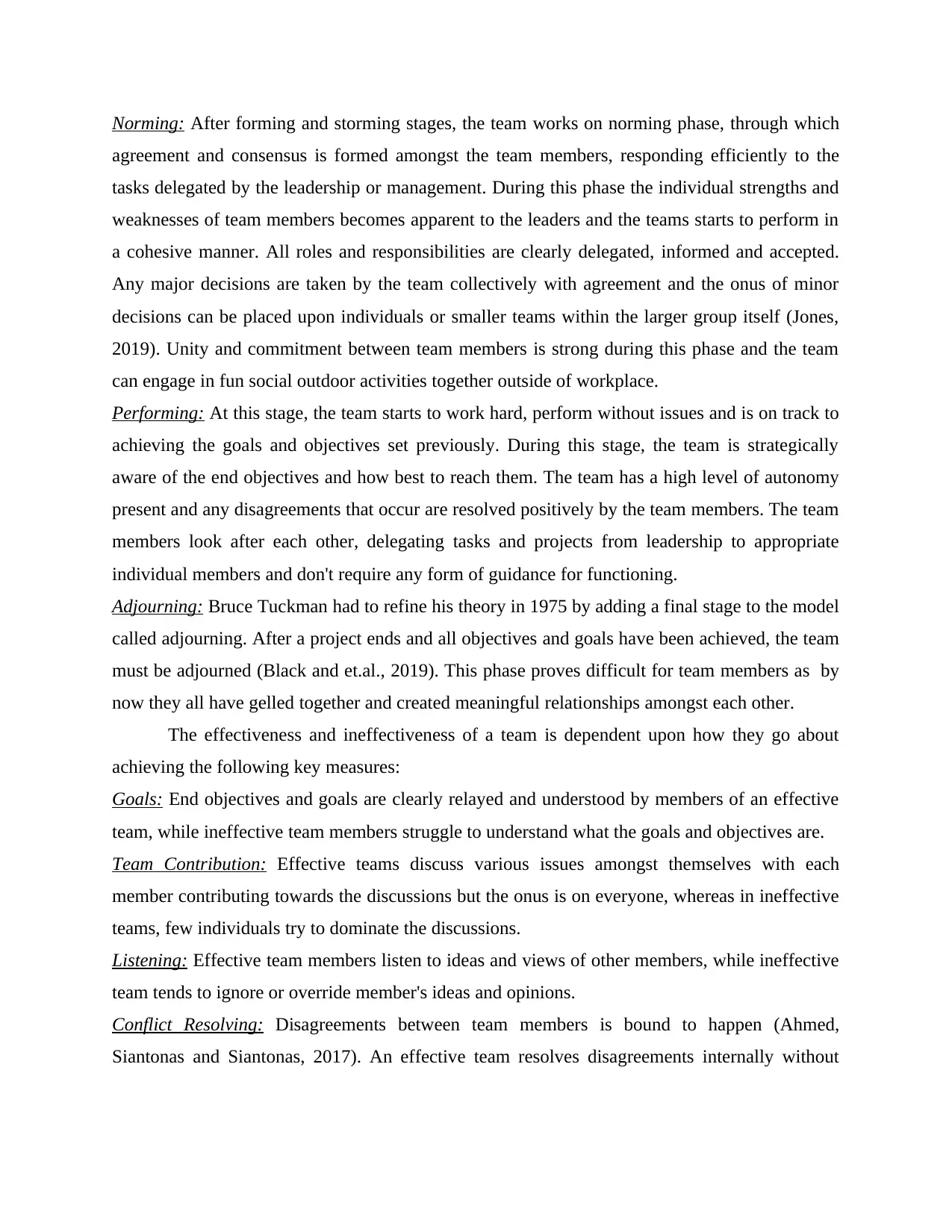
Norming: After forming and storming stages, the team works on norming phase, through which
agreement and consensus is formed amongst the team members, responding efficiently to the
tasks delegated by the leadership or management. During this phase the individual strengths and
weaknesses of team members becomes apparent to the leaders and the teams starts to perform in
a cohesive manner. All roles and responsibilities are clearly delegated, informed and accepted.
Any major decisions are taken by the team collectively with agreement and the onus of minor
decisions can be placed upon individuals or smaller teams within the larger group itself (Jones,
2019). Unity and commitment between team members is strong during this phase and the team
can engage in fun social outdoor activities together outside of workplace.
Performing: At this stage, the team starts to work hard, perform without issues and is on track to
achieving the goals and objectives set previously. During this stage, the team is strategically
aware of the end objectives and how best to reach them. The team has a high level of autonomy
present and any disagreements that occur are resolved positively by the team members. The team
members look after each other, delegating tasks and projects from leadership to appropriate
individual members and don't require any form of guidance for functioning.
Adjourning: Bruce Tuckman had to refine his theory in 1975 by adding a final stage to the model
called adjourning. After a project ends and all objectives and goals have been achieved, the team
must be adjourned (Black and et.al., 2019). This phase proves difficult for team members as by
now they all have gelled together and created meaningful relationships amongst each other.
The effectiveness and ineffectiveness of a team is dependent upon how they go about
achieving the following key measures:
Goals: End objectives and goals are clearly relayed and understood by members of an effective
team, while ineffective team members struggle to understand what the goals and objectives are.
Team Contribution: Effective teams discuss various issues amongst themselves with each
member contributing towards the discussions but the onus is on everyone, whereas in ineffective
teams, few individuals try to dominate the discussions.
Listening: Effective team members listen to ideas and views of other members, while ineffective
team tends to ignore or override member's ideas and opinions.
Conflict Resolving: Disagreements between team members is bound to happen (Ahmed,
Siantonas and Siantonas, 2017). An effective team resolves disagreements internally without
agreement and consensus is formed amongst the team members, responding efficiently to the
tasks delegated by the leadership or management. During this phase the individual strengths and
weaknesses of team members becomes apparent to the leaders and the teams starts to perform in
a cohesive manner. All roles and responsibilities are clearly delegated, informed and accepted.
Any major decisions are taken by the team collectively with agreement and the onus of minor
decisions can be placed upon individuals or smaller teams within the larger group itself (Jones,
2019). Unity and commitment between team members is strong during this phase and the team
can engage in fun social outdoor activities together outside of workplace.
Performing: At this stage, the team starts to work hard, perform without issues and is on track to
achieving the goals and objectives set previously. During this stage, the team is strategically
aware of the end objectives and how best to reach them. The team has a high level of autonomy
present and any disagreements that occur are resolved positively by the team members. The team
members look after each other, delegating tasks and projects from leadership to appropriate
individual members and don't require any form of guidance for functioning.
Adjourning: Bruce Tuckman had to refine his theory in 1975 by adding a final stage to the model
called adjourning. After a project ends and all objectives and goals have been achieved, the team
must be adjourned (Black and et.al., 2019). This phase proves difficult for team members as by
now they all have gelled together and created meaningful relationships amongst each other.
The effectiveness and ineffectiveness of a team is dependent upon how they go about
achieving the following key measures:
Goals: End objectives and goals are clearly relayed and understood by members of an effective
team, while ineffective team members struggle to understand what the goals and objectives are.
Team Contribution: Effective teams discuss various issues amongst themselves with each
member contributing towards the discussions but the onus is on everyone, whereas in ineffective
teams, few individuals try to dominate the discussions.
Listening: Effective team members listen to ideas and views of other members, while ineffective
team tends to ignore or override member's ideas and opinions.
Conflict Resolving: Disagreements between team members is bound to happen (Ahmed,
Siantonas and Siantonas, 2017). An effective team resolves disagreements internally without
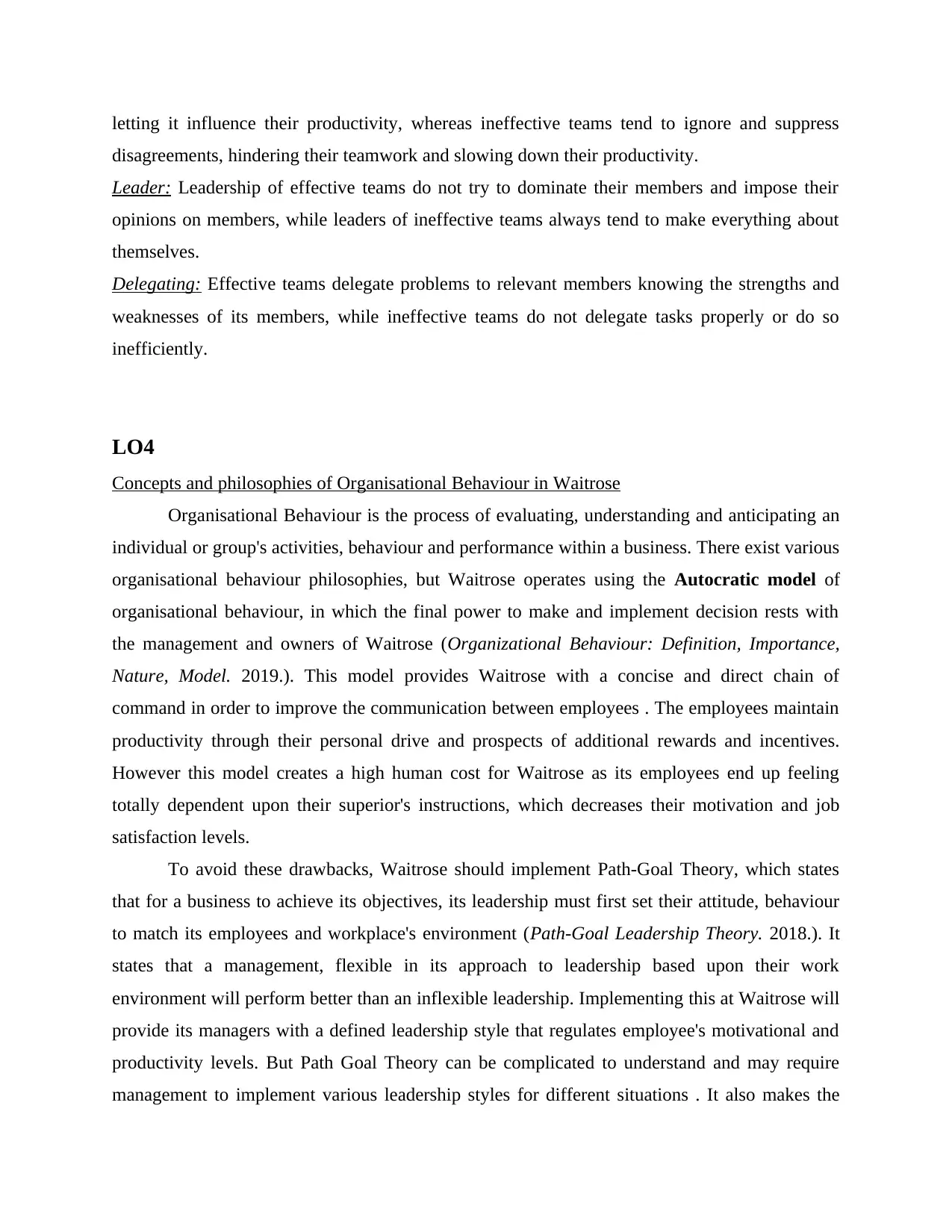
letting it influence their productivity, whereas ineffective teams tend to ignore and suppress
disagreements, hindering their teamwork and slowing down their productivity.
Leader: Leadership of effective teams do not try to dominate their members and impose their
opinions on members, while leaders of ineffective teams always tend to make everything about
themselves.
Delegating: Effective teams delegate problems to relevant members knowing the strengths and
weaknesses of its members, while ineffective teams do not delegate tasks properly or do so
inefficiently.
LO4
Concepts and philosophies of Organisational Behaviour in Waitrose
Organisational Behaviour is the process of evaluating, understanding and anticipating an
individual or group's activities, behaviour and performance within a business. There exist various
organisational behaviour philosophies, but Waitrose operates using the Autocratic model of
organisational behaviour, in which the final power to make and implement decision rests with
the management and owners of Waitrose (Organizational Behaviour: Definition, Importance,
Nature, Model. 2019.). This model provides Waitrose with a concise and direct chain of
command in order to improve the communication between employees . The employees maintain
productivity through their personal drive and prospects of additional rewards and incentives.
However this model creates a high human cost for Waitrose as its employees end up feeling
totally dependent upon their superior's instructions, which decreases their motivation and job
satisfaction levels.
To avoid these drawbacks, Waitrose should implement Path-Goal Theory, which states
that for a business to achieve its objectives, its leadership must first set their attitude, behaviour
to match its employees and workplace's environment (Path-Goal Leadership Theory. 2018.). It
states that a management, flexible in its approach to leadership based upon their work
environment will perform better than an inflexible leadership. Implementing this at Waitrose will
provide its managers with a defined leadership style that regulates employee's motivational and
productivity levels. But Path Goal Theory can be complicated to understand and may require
management to implement various leadership styles for different situations . It also makes the
disagreements, hindering their teamwork and slowing down their productivity.
Leader: Leadership of effective teams do not try to dominate their members and impose their
opinions on members, while leaders of ineffective teams always tend to make everything about
themselves.
Delegating: Effective teams delegate problems to relevant members knowing the strengths and
weaknesses of its members, while ineffective teams do not delegate tasks properly or do so
inefficiently.
LO4
Concepts and philosophies of Organisational Behaviour in Waitrose
Organisational Behaviour is the process of evaluating, understanding and anticipating an
individual or group's activities, behaviour and performance within a business. There exist various
organisational behaviour philosophies, but Waitrose operates using the Autocratic model of
organisational behaviour, in which the final power to make and implement decision rests with
the management and owners of Waitrose (Organizational Behaviour: Definition, Importance,
Nature, Model. 2019.). This model provides Waitrose with a concise and direct chain of
command in order to improve the communication between employees . The employees maintain
productivity through their personal drive and prospects of additional rewards and incentives.
However this model creates a high human cost for Waitrose as its employees end up feeling
totally dependent upon their superior's instructions, which decreases their motivation and job
satisfaction levels.
To avoid these drawbacks, Waitrose should implement Path-Goal Theory, which states
that for a business to achieve its objectives, its leadership must first set their attitude, behaviour
to match its employees and workplace's environment (Path-Goal Leadership Theory. 2018.). It
states that a management, flexible in its approach to leadership based upon their work
environment will perform better than an inflexible leadership. Implementing this at Waitrose will
provide its managers with a defined leadership style that regulates employee's motivational and
productivity levels. But Path Goal Theory can be complicated to understand and may require
management to implement various leadership styles for different situations . It also makes the
⊘ This is a preview!⊘
Do you want full access?
Subscribe today to unlock all pages.

Trusted by 1+ million students worldwide
1 out of 20
Related Documents
Your All-in-One AI-Powered Toolkit for Academic Success.
+13062052269
info@desklib.com
Available 24*7 on WhatsApp / Email
![[object Object]](/_next/static/media/star-bottom.7253800d.svg)
Unlock your academic potential
Copyright © 2020–2025 A2Z Services. All Rights Reserved. Developed and managed by ZUCOL.





